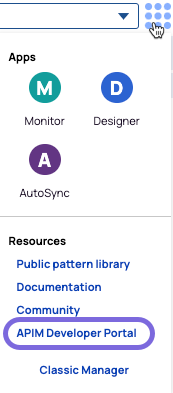API Manager -Design First Workflow
Prerequisites
The API
Manager feature requires a load balancer.
Cloudplexes need a Cloudplex FeedMaster node and a load balancer for the API Policy Manager
Support and Limitations
For Cloudplex users, you must set up a load balancer for the API Policy Manager to work.to work.
Contact support@snaplogic.com to provision the Cloudplex FeedMaster node and the load balancer as needed.
When the load balancer becomes available, your Org admin must update the Load Balancer URL in the Snaplex Settings. Learn more.
You must use the load balancer URL in your Triggered and Ultra Task endpoints.
The API Management feature must be enabled for your Org. Contact SnapLogic Support to subscribe to this feature.
Limitations
APIM does not support the Cloud URL to run the Triggered Tasks in your API Versions.
Orgs with APIM should not use Enhanced Encryption for the following reasons:
Orgs with Enhanced Encryption do not support subscriptions on the Developer Portal.
Org admins who rotate keys for their Groundplexes must also reconfigure all API policies as well for them to work.
Only one instance of an API policy
type is applicable at
each level in the hierarchy.
API Manager does not support Scheduled Tasks. When you open a Task in an API version, you
do not have the option to change the Run Policy to Scheduled.
In Designer, when you open a Pipeline in an API version, the Snaplex
picker in the Edit Pipeline dialog window only
show the Snaplex instances from the global
sharedfolder. If a Snaplex is in a project or Project Spacesharedfolder, then it does not display in the APIM Snaplex picker.In Designer,
if you open the Snap dialog window
from a Pipeline in the API Management -
/apimspace,
the asset or account selectors display only the assets from the global shared folder, in addition to those in the current version
.
What is the difference between API Management and the Native API Manager?
API Management covers all aspects of managing APIs, from creation, testing, deployment, versioning and sharing it with API consumers. The API Manager console allows you to define and create an API through uploading or referencing a Swagger specification. You can also create versions and add permissions and policies at the Org/APIM, API, and version levels.
Can I still use the Native API Manager to publish Ultra and Triggered Tasks to the existing Developer Portal?
Yes. However, the Native API Manager will be deprecated in the August 2021 release and replaced by the API Portal Manager, which will be added to the API Management section of the SnapLogic Manager.
How do I enable the API Management Design First feature for the 4.25 release?
In the 4.25 release (May 2021), your Org must have the following subscription features:
- API Management feature to access the Design First features, the API Policy Manager, and the API Dashboard.
- Native API Manager to access the API Policy Manager.
Is the Native API Manager Developer Portal feature supported in the new API Management Design First feature?
No. APIs and versions created through the API Management-Design First approach cannot be published using the Native API Developer Portal in the 4.25 release.
Are there plans to add a Developer Portal support to API Management?
Yes. In the August release, we plan to deliver a Developer Portal with equivalent functionality as the existing one in Native API Manager.
Can I still add API policies to projects and Tasks in the next release with API Management Design First?
Yes, you can still add policies at the Org and Project Space levels for your Ultra and Triggered Tasks.
If I have APIs on the Developer Portal published through the Native API Manager, will those APIs be compatible with the Developer Portal in the future?
SnapLogic will work with customers who currently have a Developer Portal to migrate their published APIs to the new Developer Portal that will be available in the 4.26 release.
You can change the Snaplex for an unpublished API version. To do so, go to API Manager, choose the API, go to the Versions tab, choose the version, click Edit Details, and choose from the Server dropdown. Note: This field is disabled if the API version is published or if the Snaplex is down.
When you generate a specification using version OAS 3.0 in an API proxy that has a valid endpoint, the generated specification does not list a server.
Known Issues
When you generate a specification using version OAS 3.0 in an API proxy that has a valid endpoint, the generated specification does not list a server.
Workaround: Edit the specification to include the server field and list the Snaplex manually.When you create an API from an existing Project, choosing the Assets and Snaplex in the dialog, API creation is successful, and all the assets have been imported successfully. However, tasks still use the previous Snaplex, if the Snaplex is not active.
Workaround: Set the Snaplex for each task manually.


